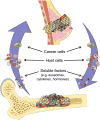The cancer diaspora: Metastasis beyond the seed and soil hypothesis
- PMID: 24100626
- PMCID: PMC3835696
- DOI: 10.1158/1078-0432.CCR-13-2158
The cancer diaspora: Metastasis beyond the seed and soil hypothesis
Abstract
Do cancer cells escape the confinement of their original habitat in the primary tumor or are they forced out by ecologic changes in their home niche? Describing metastasis in terms of a simple one-way migration of cells from the primary to the target organs is an insufficient concept to cover the nuances of cancer spread. A diaspora is the scattering of people away from an established homeland. To date, "diaspora" has been a uniquely human term used by social scientists; however, the application of the diaspora concept to metastasis may yield new biologic insights as well as therapeutic paradigms. The diaspora paradigm takes into account, and models, several variables including: the quality of the primary tumor microenvironment, the fitness of individual cancer cell migrants as well as migrant populations, the rate of bidirectional migration of cancer and host cells between cancer sites, and the quality of the target microenvironments to establish metastatic sites. Ecologic scientific principles can be applied to the cancer diaspora to develop new therapeutic strategies. For example, ecologic traps - habitats that lead to the extinction of a species - can be developed to attract cancer cells to a place where they can be better exposed to treatments or to cells of the immune system for improved antigen presentation. Merging the social science concept of diaspora with ecologic and population sciences concepts can inform the cancer field to understand the biology of tumorigenesis and metastasis and inspire new ideas for therapy.
Figures

References
-
- Androutsos G, Karamanou M, Stamboulis E, Tsoucalas G, Kousoulis AA, Mandelenaki D. Joseph-Claude-Anthelme Récamier (1774-1852): forerunner in surgical oncology. J BUON. 2011;16(3):572–6. - PubMed
-
- Paget S. The distribution of secondary growths in cancer of the breast. Lancet. 1889;133:571–573. - PubMed
-
- Ewing J. Neoplastics. 3rd. Philadelphia: Saunders; 1928. Metastasis; pp. 77–89.
-
- Pienta KJ, Loberg R. The “emigration, migration, and immigration” of prostate cancer. Clin Prostate Cancer. 2005;4:24–30. - PubMed
-
- Fidler IJ. The pathogenesis of cancer metastasis: the ‘seed and soil’ hypothesis revisited. Nat Rev Cancer. 2003;3:453–458. - PubMed
Publication types
MeSH terms
Grants and funding
LinkOut - more resources
Full Text Sources
Other Literature Sources

